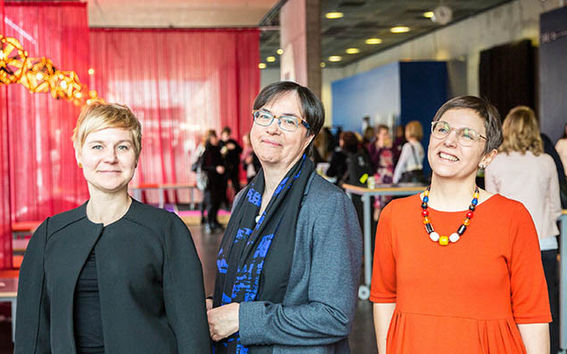Service design starts from people

The concept of design in the service sector has over the decades evolved from interior design to usability and from user experience to services. Service design was settling in Finland by the time Helsinki was the World Design Capital around five years ago. In the public sector, especially cities have woken up to the possibilities provided by design in a situation of constant change.
Professor Tuuli Mattelmäki from the Aalto University Department of Design has worked in close cooperation with, for example, the City of Helsinki for several years.
‘Cities collaborate with a network of several different actors, which makes service paths extremely challenging. Through design, service paths and services can be made more customer-centric,’ Tuuli Mattelmäki says.
Collaboration in developing the services of the City of Helsinki provides a rich ‘design platform’ for Aalto University’s researchers and students. Collaboration projects in the Designing for Services course have focused on the societal role of design from the point of view of challenges in health care and social services provided for children, the elderly, and immigrants.
The result is services and tools that facilitate everyday life and make the service entity more structured and meaningful: the Nurse Café for visiting a nurse, the Askeleet (‘Steps’) game designed for introducing children’s health check-ups to day care centres as well as an application that structures and visualises the service paths immigrants need in the beginning, from KELA to the services of the police and the tax office.
‘Especially the students’ emphatic but at the same time bold and critical approach has received a lot of positive feedback. Human understanding accompanied with the right kind of competence and attitude are important characteristics and tools for today`s designers,’ says Mattelmäki.
‘Designing change is often public relations. It requires holistic thinking and working together,’ Mattelmäki summarises.
Two sides of service experience
A product or a service that works is not enough today – it must also provide the users with added value.
‘A good service experience provides added value for the customer and improves the profitability of the business,’ says Service Designer Kirsikka Vaajakallio, who is responsible for customer-centric development of organisations at Hellon, a service design agency specialised in customer-centric change.
According to Vaajakallio, a service experience always has two sides: the customer’s experience and the experience of the employee designing or producing the service – both of which are equally important.
‘A good employee experience ensures a good customer experience. Good things often happen in the interface of employee and customer experiences,’ says Vaajakallio.
According to Vaajakallio, technology is overtaking the human and therefore it is important to return the human to the centre of development. It pays to invest in customers and users of services but also in the companies’ own employees as a part of providing good service experiences.
‘To understand customer experience, you have to know how people live. Everything starts from people – from thinking human to human.’
‘We also have to be aware that customer experience is built at many levels, in services as well as at systemic and strategic levels. If you understand the starting point, you can start from anything,’ Vaajakallio reminds us.
Professor Anne Stenros sees a connection between values and customer experience.
‘Values, too, are experienced at three levels: individual, communal and societal. Values also determine the customer experience,’ says Stenros, who has a long career in managerial positions in the field of design.
Stenros, who leads the Master’s Programme of International Design Business Management, brings up the operating practices in working life among those born in the 80s and 90s. Millennials and the so called Z generation that comes after them will revolutionise working.
‘Now we are doing human-to-human business. Millennials want to operate together, crowdsource: when one gets tired of leading, someone else will take over,’ says Stenros.
Service design gathered together a large number of people interested in the subject in Media Centre Lume on the International Women’s Day on 8 March.
Photos Mikko Raskinen, Aalto University
Read more news

DeployAI Partners Gather for Heart Beat Meeting in Helsinki
The European DeployAI project's partners gathered for the Heart Beat meeting hosted by Aalto University Executive Education in Helsinki.
Key Skills for Sustainability Experts: Collaboration and Communication
As industries increasingly focus on sustainability, the demand for sustainability expertise is growing. But what specific skills do employers seek in sustainability experts?Unite! Research Week in Grenoble-Autrans, 14-18 October
A networking event focusing on AI, Energy and Industry 4.0 for faculty and doctoral studentsSummmer break in HR service point and new opening hours starting from 6 August 2024
HR service point is closed on 28 June - 5 August 2024. New opening hours are tuesday - thursday at 12.00 - 15.00 starting from 6 August 2024.Please note that the opening hours will change starting from 6 August 2024.